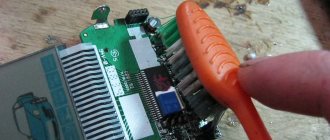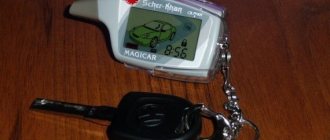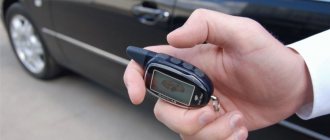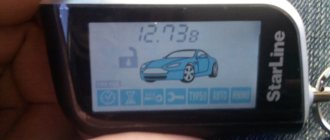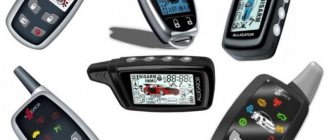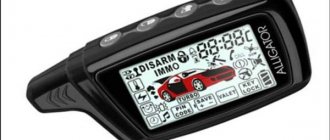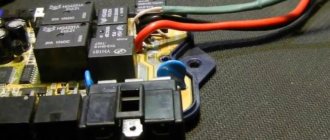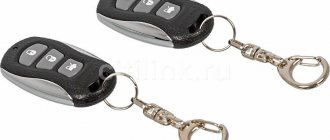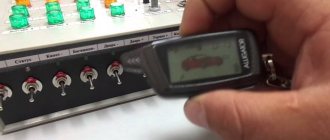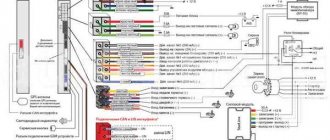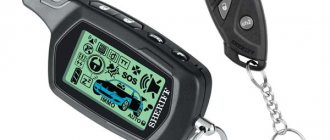In this article we will talk about typical malfunctions of Alligator remote controls - we will note the features of self-diagnosis and ways to eliminate them.
A common problem is that the Alligator alarm does not respond to the key fob. Probable reasons.
- The battery is dead - a common problem. Pay attention to the capacity indicator; if it is at a minimum, replace the battery. In key fobs with one-way communication, the cause can be identified with a multimeter.
- The alarm remote control is damaged - such a malfunction often appears gradually. Usually the rubber bands of the buttons wear out, and sometimes the main elements of the key fob are damaged due to mechanical injury. The problem is solved by replacing it.
- Failure in memory and settings - sometimes the alarm “forgets” the remote control and does not respond to it. Try re-registering all the units using the “Jack” button.
- Incorrect installation of alarm elements - some of the controllers are installed deep in the machine, so the signal does not pass through. If there is no reception, try unlocking the car from different positions.
Find out everything about programming the KGB alarm key fob.
Remote control does not open the car
The Alligator key fob with two-way communication monitors the status of the main security systems and displays information on the display. Some models are equipped with an autostart function. Characteristics of such keychains.
- A-9 – autostart system. The buttons are located on the back of the display. The key fob has a high degree of protection (8192 channels), the response time is a quarter of a second. Data about previous violations and power outages remain in memory.
- C-2 – remote control buttons are conveniently located under the display. The key fob is protected from hacking by a reliable BACS code; in the event of an attempted theft, the Anti-Highjack option allows you to stop the engine in a timely manner.
- C-2 C – provides two-stage arming. When hacking or sensors are triggered, information is displayed on the display by flashing icons.
- C-3 C – key fob with two-way communication, allows you to start the engine at a distance of up to 1.2 km. The remote control has a convenient body without an antenna.
- C-5 is a model with a metal frame, two main buttons are located under the display, three on the side. On the monitor, the data is displayed in a creeping line, there is a Russified menu. Improved radio signal reception up to 2.5 km.
If the key fob stops working, you can carry out diagnostics yourself. The table below provides basic information on faults and how to resolve them.
| Probable Cause | Actions |
| My battery is almost done | install a new battery |
| remote control is faulty | use a spare key fob |
| no connection | try opening the car later |
| the switch was erased from memory when replacing the battery | carry out the memorization procedure again |
| The central lock is faulty | contact the master |
Find out everything about the compatibility of KGB key fobs with other remote controls.
Alligator pager with one-way communication does not work
The Alligator two-button alarm key fob is equipped with a minimum of functions and is usually used as a spare unit. Some pagers may have additional keys. With its help you can open the car and arm it. Popular models.
- A-LIGHT – on the case there are two main buttons and auxiliary keys located vertically. The pager allows you to set the silent mode and block the engine.
- M 2200 – equipped with three buttons. The body is small, elongated, ergonomic in shape.
- NS-505 is a three-button pager, all keys are located in the center. Powered by the Keeloq encryption system.
- A-1 S is a standard three-key switch. A budget option with a classic set of features.
- A-2 S – outwardly no different from the previous one, equipped with options that the first one does not have. Works at a distance of 50 meters.
- A-3 S – the third generation is the most advanced of the budget series. There is an anti-theft function called Anti-Hijack, and there is a dynamic anti-hacking code.
Sometimes it happens that the second key fob fails - possible culprits are listed in the table.
| Probable Cause | What to do |
| No power supply | replace the battery or open the car with a second key fob |
| button broken | use a spare pager, change the key |
| there is interference | try opening the car with a different remote control |
| after removing the terminal from the battery, the key fob is erased from memory | re-flash the firmware |
Problems with autostart for the Alligator key fob
Alligator alarms with auto-start function are represented by the following models:
- A-9;
- C-3 C;
- C-5;
- C 300;
- C 350;
- TD-350;
- C 500;
- S-825RS.
All variants are equipped with two-way pagers that allow remote engine starting. Using the key fob, you can set the start by time and temperature.
Potential reasons why the engine will not start:
- the system is not configured for autostart;
- the car is faulty;
- The head unit does not see the key fob.
To set up autostart, put the car in neutral mode - with the engine running, pull the handbrake, then remove the keys from the ignition. Get out of the car, slam the door and lock the central lock using the pager. The engine stalls - the car is ready to autostart.
Setting up autostart (using the example of models C-500, C-5, TD-350):
- hold down the F button for 2 seconds until a beep sounds;
- in a few seconds. the car will start.
To configure timed triggering:
- additionally hold down the service button for 2 seconds;
- use the “open lock” key to set the time;
- exit is performed automatically.
To set temperature trigger:
- additionally hold down the service button for 2 seconds;
- press the “open lock” key;
- press the service button;
- exit is performed automatically.
We also have instructions for the Sheriff Aps95lcd b4 key fob.
Security system capabilities
Functionality depends on the selected model. Common features include:
More expensive car security devices provide a number of additional features:
Alligator alarm system , regardless of configuration, provides complete vehicle protection. All data is encrypted with codes. Each series of products is equipped with unique encryption mechanisms.
Modes
"Panic"
The mode activates an alarm. Valid with or without the security mechanism. When started in Valet mode, the vehicle will return to it after the alert ends.
To activate, press and hold the lock and unlock keys on the transmitter. After switching on, a sound alert will start and the turn signals will also start flashing. To turn off the alarm, press the indicated buttons again. The signals will stop and the system will return to its original state.
"Valet"
The mode is designed to disable security mechanisms, for example, at a vehicle inspection station. If a dangerous situation arises, it allows you to activate the “Panic” mode.
Activation occurs in several stages. To start the mode, perform the following sequence of actions:
To disable the mode, repeat the steps above. After this, the system will emit 2 short beeps and the indicator will go off.
"Anti Hijack"
Allows you to automatically block the electrical circuit one and a half minutes after an unauthorized engine start. To activate, hold down the corresponding button. After starting, the indicator will light up.
When the attacker starts the engine, it will not be possible to turn it off using the key fob transmitter. Therefore, the mode is relevant in case of theft or loss of keys. After a minute, the system will begin to make sharp loud sounds. Then the turn signals will start flashing. After 90 seconds the starter will be locked.
To disable the mode, use the “Valet” .
The buttons are blocked
On the following Alligator alarm models, you can enable button blocking from accidental pressing:
- A 1;
- A 3;
- A 3 S;
- A 9;
- C 300, 325;
- TD 350;
- M 1500;
- C 500;
- S 725 RS, 325;
- D 910;
- S 250;
- M 2200, 975;
- S 850 RS;
- M 2200;
- S 875RS;
- M-2 T;
- S 200;
- M 800;
- S 400;
- D 930.
Sometimes the lock is accidentally activated by pressing the buttons at the same time or due to a short circuit with condensation. How to unblock:
- hold down F and at the same time the open and closed lock key;
- The lock is placed in the same way.
The switch shows nothing
Sometimes it happens that the remote control does not display any icons - usually only the backlight is on, the alarm responds to commands in normal mode. This problem occurs on the following Alligator alarm models:
- LX 440;
- A 2;
- NS 505;
- A 1 S;
- C 2C;
- S 400;
- S 825 RS;
- M 700;
- A 2 S;
- D 1000, 868;
- C 2;
- SP 75 RS;
- SP-30, 55.
The most common reason is that the battery is dead, the alarm system is faulty or there is no feedback. You need to replace the battery and repeat the procedure after a while. If the problem is not solved, try flashing all key fobs in the device memory. If there is no result, take the remote control for repair. See how to find out the Sheriff alarm model.
New cars > Car alarms >
Author of the material: Dumchenkov Mikhail
Did you like the material? Share with your friends:
Have questions about car repairs? Ask them in the consultation section, to do this, click on the link below.
auto mechanic
- Acura
- Alfa Romeo
- Audi
- Bentley
- BMW
- Cadillac
- Chery
- Chevrolet
- Citroen
- Daewoo
- Dodge
- Fiat
- Ford
- GAZ
- Geely
- Hawtai
- Honda
- Hyundai
- Infiniti
- Jaguar
- Jeep
- KIA
- Land Rover
- Lexus
- Lifan
- Lincoln
- Mazda
- Mercedes-Benz
- Mini
- Mitsubishi
- Nissan
- Opel
- Peugeot
- Porsche
- Renault
- Skoda
- SsangYong
- Subaru
- Suzuki
- Toyota
- UAZ
- VAZ
- Volkswagen
- Volvo
© 2022 Daciaclubmd.ru. If you do not agree with any provision of this Disclaimer, do not use this Site. Please read Disclaimer and Privacy Policy before use.
Copying materials is permitted only with an active hyperlink to our website.
But here’s the problem: it doesn’t always respond to pressing the key fob (LCD, 2-way communication). Sometimes you have to press the button several times, sometimes you have to hold it, or maybe all at once. I changed the battery.
Then, there is no status on the LCD. The open lock is always on (which indicates that the car is not armed), regardless of whether it is armed or not. It very rarely happens that a closed lock and the inscription “alarm” appear on the key fob (almost never). When activated, the LCD is silent like a partisan.
The key fob reacts adequately to pressing (it always gives confirmation signals), but the alarm unit does not always respond. I rang all the wires going from the antenna to the unit. Everything is great. I leaned the key fob close to the antenna - nothing changes: sometimes the unit does not respond to key fob presses, and there is still no signal status on the LCD.
What is this? Is the key fob going bad or the alarm itself?
If you change it, please suggest a model similar (pinout, etc.) to the alligator s300 (so as not to have to deal with dismantling/installation, even partial), and very preferably with an autostarter function (this, I understand, cannot be done without additional installation). What I said above about the reluctance to engage in dismantling/installation applies only to the usual alarm functions (arming, disarming, output channels: ESP, trunk opening, etc.).
And in parallel, what autostarter do you recommend for this alarm? Alarm Alligator S300, car GAZ-3110 ZMZ406 (no gearshift knob position sensor), 1 alarm channel is dedicated to closing the ESP when arming, the second is for opening the trunk (I’m ready to sacrifice the second and connect the autostarter to it).
Briefly about the system (Novosibirsk development!):
——————— Absolute ARS-201 Engine starting device Key features · Control of engine starting and operation by speed or by on-board network voltage. · Possibility of installation on cars with both gasoline and diesel engines. · Warm-up time 10, 15, 25 minutes (programmable). · Instant shutdown of the starter when starting the engine. · Programmable power output to power third ignition circuit or accessories. · Maximum starter operating time 2, 4, 6, 8 seconds (programmable). · Possibility of automatic start at intervals of 1, 2, 3 or 4 hours. · Thermostat mode, which allows you to start the engine when it cools down to a given temperature, measured using a standard sensor. · Daily timer that allows you to start the engine at the same time of day. · Possibility of installation on cars with both automatic and manual transmissions. · Complicated starting condition for manual transmission, ensuring the safety of using the device. · Short stop mode (Pit-Stop mode), allowing you to leave the car with the engine running (for automatic transmission). · Automatic detection of the moment of readiness to start the engine (for diesel engines). · Programmable polarity of door status input signal. · Diagnostics by flashing side lights. · Flexibility and ease of programming. · Protection against accidental changes to settings that are configured once. · Ability to turn off the device using a switch. · Protection against accidental activation by limiting the command duration (0.1 – 10 seconds). · Three attempts to start. · Two groups for switching the shock sensor/engine unlock relay. ——————-
The first “blunder”: the installation manual says: “3 emergency engine stop inputs. One negative and 2 positive. A signal for an emergency stop of the engine is the appearance of an active level for a period of more than 0.3 seconds. Unconnected inputs have passive levels. These inputs are designed to connect to the hood switch (negative), parking brake switch (positive), brake light circuit (positive).” Those. It turns out that if the brake pedal is pressed - stop, the hood is open - stop, and damn, the handbrake - stop. This is according to how it is interpreted in the manual! Even when I was figuring it out, I thought, what the hell: after all, if you take a signal from the handbrake, then when you put the handbrake on, a plus will come to the device! I decided not to connect the handbrake, because... By default it says the input will be a passive signal.
It soon turned out that it was in vain. Apparently they described the principle of action incorrectly. And the active signal on the handbrake is “minus”. It doesn’t matter, I’ll connect +12V from the ignition there, let him think that the handbrake is on (9 months of winter a year, putting it on the handbrake means almost always changing the rear pads after that). The automatic transmission mode is temporarily set (which doesn’t care about the presence of a handbrake)
2 glitch: It is possible to turn off the starter both due to a voltage drop on the battery and due to a signal from the tachometer.
When it worked due to voltage drop, everything worked with a bang (programmed by default). I decided that this is not reliable (in severe frosts the battery will be quite discharged, and according to this drop, I’m afraid the starter will release before the engine “grabs it”), and programmed it using the tachometer (though it’s a shame, because for this purpose To get a signal from the tachometer, I had to remove the instrument panel!). There were 2 wires going to the tachometer: one was the 12V power supply, the other was the tachometer signal - 50-70 mV (and changed when the gas pedal was pressed). He took it.
After setting the tachometer control, it was necessary to program the idle speed (done so that the engine knows the norm and makes an emergency stop in the event “if the idle speed exceeds the norm by 4 times, or drops by 2 times relative to the norm”). Programmed. Successfully! I start it remotely: everything is ok. I’m happy, I’m thinking about drinking beer now. I set the alarm with the engine running (started it remotely) - the system is armed and the car stalls! I tried it several times - the effect was the same. I get into the car and start it remotely. Once it starts, I put it on security (or disarm it). The tachometer needle was at 800-900 rpm and remained motionless. The car is armed (disarmed) and then stalls. I am diagnosing the autostrater. Diagnosis: “Engine speed has exceeded the upper permissible limit (when controlled by speed).” What kind of nafik is this? Tips? I do it differently: I sit in the car, start it from the remote control, turn on the additional electric pump (it consumes a lot, about 4-5A, when you turn on this button, you can immediately visually notice how the voltage drops), the result is that it stalls. Diagnostics again shows that an emergency stop was made due to the exceeded idle speed.
On various automotive forums, the most common question is about alarm malfunctions: there is no feedback from the key fob. Quite often the alarm system stops working and key fobs break. The cause of the key fob failure may be a dead battery or a discharged battery. But, of course, there are more serious problems.
It turns out that feedback alarms cause a lot of trouble. Significantly more malfunctions occur in winter. In summer there are much fewer of them. Key fobs and alarms fail equally. It is curious that in most cases, drivers themselves are to blame for alarm malfunctions when it does not have feedback from the key fob.
- Mechanical damage to the key fob.
All breakdowns of alarm units and key fobs are divided into two groups: mechanical and electronic. Mechanical failures occur as a result of impact or exposure to chemicals. Electronic – failures in system settings. Often, when a key fob falls on asphalt or any other hard surface or is hit with something heavy, the internal structure, electronics, and processor are damaged. In this case, the case may become unusable, the display may be scratched, or cracked. In this case, it becomes impossible to use the key fob.
The most common and classic malfunction that occurs from impact and deformation of the key fob body is a breakdown of the power supply circuit inductor in the converter. This part is made of ferrite, a material that is fragile to mechanical stress. As you know, the throttle is replaced exclusively at a service center for a fee.
As a result of a sufficiently strong impact or pressure, the case and electronic board are damaged, and the processor pins on it are damaged. Of course, this problem can be fixed. It is necessary to solder the parts to the board, but the quality of the key fob will be worse.
Mechanical damage includes the harmful effects of moisture on electronics. Very often, alarm key fobs end up drowned in various liquids, which renders them unusable. You need to handle the keychain with extreme care, because it is not necessary to completely wet it; contact with wet hands can also cause corrosion. A humid environment acts slowly, but the process is still irreversible, because the key fob body is not sealed. We need to remember this.
For the internal structure of the key fob, it is equally unacceptable for even the smallest amount of moisture to enter. It will not work fully because the electronics fail.
It is necessary to remember one more point; often the owner of the key fob is himself to blame for its malfunction.
In order to remove the battery from the case, it is pulled out with a very sharp knife or other object. As a result, the key fob can receive a lot of damage: there is a high risk of deformation of the case and rather delicate electronics. All these processes are irreversible. Repairs must be carried out correctly and carefully.
Try not to open the key fob unless absolutely necessary.
- Electronic faults of the key fob.
Let's look at the causes of electronic problems. There is also a rather rare type of electronic malfunction. The culprit of such a breakdown is static electricity. Key fobs of some models have such a device that a static discharge reaches the electronics through the carabiner, severely damages it, and destroys the processor. As a result, it is necessary to change the processor. This is where the problems begin: you need custom firmware for a specific key fob, you will need to wait for the manufacturer to make and deliver a new key fob.
- Mechanical faults of alarm units.
Let's discuss the features of breakdowns of alarm units. Among them there are also: mechanical and electronic faults.
The owner of the car cannot be considered the culprit for a mechanical breakdown of the alarm unit itself; here, most often, the installer did not do his job properly. If, during installation, an error is made in choosing the location and, possibly, water gets in: during washing, rain, from road puddles.
Quite often the block ends up next to the stove pipes. As a result of a rupture of the pipe, a very harmful chemical liquid - antifreeze - gets onto the unit. The block becomes unusable within 24 hours. Such cases cannot be called regular, but they occur quite often.
You definitely need to remember one more point. Often, car owners, when washing the glass inside the car, use liquid for external use, in the place where the antenna modules are located. If this liquid gets inside the antenna module housing, the device fails. It should be clarified that after “washing”, corrosion develops quickly, and the antenna module can no longer be restored. For a new module you will have to pay about 1000 rubles.
- Electronic malfunctions of alarm units.
Incorrect installation and improper operation will cause a lot of inconvenience.
It's no secret that a large number of companies that manufacture alarms are very fond of saving money; they almost never put something into the system without which the device, in principle, can work. Most often, there is also no “fool protection”. As a result, there is no guarantee that when installing the alarm in the correct place, installer errors are possible during installation.
But everything is in order.
It is possible that when installing an alarm system or, in general, when installing automotive electronics, the installer may make mistakes: by connecting + to the alarm system at the usual 12 V, and disconnecting the negative contact, or without checking how well the contact is inserted, we will get a breakdown of electricity through the hood switch.
As a result, the processor of the alarm unit immediately burns out. But the matter will not stop there; all available automotive electronics will also have a long life. In terms of costs, the result will not be very happy.
Still, this is not the biggest problem of the alarm unit. Of course, there is no smoke without fire, and such moments exist. It turns out that most alarm systems cannot withstand a voltage drop of more than 18 volts. For some reason, car owners don’t remember this when purchasing an alarm system. As they say, memory returns in winter when you try to light a car. When two passenger cars are involved in this process, the alarm unit may still survive (but other options may also exist). When using a more powerful device, for example, a 220 V rectifier, the unit burns out. If you remove the terminal from the battery while the car is running, this quite often leads to breakdown of the car electronics. Also, when the contacts of the battery terminals do not fit tightly, for example, they are oxidized and sparking, this is a sign that your alarm will not have to work for long. For this reason, in winter, you can observe quite large queues of unlucky motorists near installation centers whose alarms have failed. In general, about 90% of most alarm unit problems occur due to voltage surges.
However, problems in which relays are to blame also occur. There are alarm models equipped with relays that are weak in power. During incorrect installation, in which the relay is connected to circuits through which a very strong current passes, its contacts naturally burn out. In order to exclude this, it is recommended not to install such a relay on power electrical circuits. It is best to take a much more powerful relay.
The Alligator alarm does not respond to the key fob - this is a common problem associated with low batteries, “decoupling” of the remote control from the security system, and water and foreign liquids getting inside. Another possible cause could be the antenna wire falling off, the car being in an area of strong interference, as well as a breakdown of the car alarm head unit. Below we will consider in detail how to act in such circumstances to resolve the problem.
Causes
To fix the problem, it is important to understand why the Alligator car alarm does not respond to the key fob. There may be several reasons for this:
- The power supply is discharged.
- “Decoupling” the key fob from the security system.
- Moisture leaking into the interior.
- Damage to the antenna wire in the security system head unit.
- Finding a car in an area of strong EM field.
- Failure of the security alarm head unit.
In all the cases considered, a situation may arise when the alarm from the Alligator key fob does not go off and does not respond to the remote control at all. In such circumstances, it is important to know what to do to overcome the situation.
Alarm Alligator: complete operating instructions
Alligator brand was patented in America in 1997 . Then car alarms became a real salvation for motorists - the number of thefts decreased several times. This manual contains everything about the Alligator alarm: models, security system capabilities, operating instructions.
How to fix the problem if the remote control does not respond
After studying the possible causes of the malfunction, we will move on to consider the next question - what to do if the Alligator alarm key fob breaks. To solve a problem, start with potentially simple actions and move towards more complex manipulations.
Replace the power supply
A decrease in battery charge can be diagnosed by a decrease in range. For example, if previously the Alligator alarm went off at a distance of 30 meters, now it responds to the key fob only when approaching 10-20 m. The principle of replacing the power source depends on the type of key fob. The easiest way is when a mini AA battery is installed inside. If you install a “tablet”, the device will have to be disassembled.
When replacing, pay attention to the integrity of the battery. If it has not been changed for a long time, electrolyte may leak from the device. In this case, the inside of the remote control must be washed and dried with medical alcohol. In this case, the use of solvent or acetone is prohibited.
Re-pair the remote control
One of the reasons why the Alligator alarm key fob does not work is its decoupling from the main unit. This situation may occur due to a power supply change, software glitches, reprogramming error, or due to electromagnetic interference. If the remote control is unlinked, the LED in the latter will work, but the security system does not respond to commands.
In this case, there are two ways - use a temporary second key fob or re-bind the remote control.
The binding algorithm depends on the Alligator signaling model. For example, for M series devices, do the following:
- disarm the car and turn on the ignition;
- move Jack three times to the on position;
- hold down buttons 1 or 2 on the key fob;
- press the Jack button;
- program the second channel;
- wait 15 seconds.
Clean the remote control from water
Alarm Alligator often does not see the key fob due to aggressive liquids getting inside. At the same time, water or melted snow does not cause big problems, but if liquid with salt or other aggressive components gets in, problems can arise. To restore the device to working order, disassemble the device, remove the main board and wash it with alcohol and a soft brush. After this, dry the device with a hairdryer.
If the Alligator remote control with LCD display does not work due to water ingress, you must immediately remove the battery and thereby protect the circuit from damage. As for repairs, it is better to take the key fob to specialists. They will determine the reason why it does not respond to clicks and decide on further actions.
Check the quality of the antenna wire connection in the main unit
There are situations when a person accidentally damages the antenna wire, and then wonders why the key fob in the Alligator alarm system stopped working. If this element is damaged, the range of action is significantly reduced. In the most difficult cases, a complete loss of communication between the remote control and the main unit of the security system is possible (the latter stops responding to commands). To solve the problem, check the condition of the cable and replace the remote antenna.
Move the car to an area with less interference
Sometimes the Alligator key fob does not work and does not respond to button presses due to the negative effects of EM interference. To check the performance, try moving the car to another place with less influence of electromagnetic interference.
Replace the alarm
Each device has a resource. After a certain time, the Alligator alarm may fail, after which the system does not respond to the key fob. The average lifespan is five to seven years, but this is for good models. If malfunctions occur, you can repair the security device at a service station or perform a complete replacement.
Now you know why the Alligator alarm does not respond to the key fob, and what to do to fix the problem. In the comments, share your experience in operating the security system and similar malfunctions.
If the alarm key fob does not work, then controlling the anti-theft system becomes less convenient. You can repair the device yourself, but to do this you need to understand the reasons.
Video “Repair your communicator yourself”
The AUTO REZ channel provided detailed instructions for repairing the anti-theft complex control pager.
Having a car is not only happiness and responsibility, but also periodic surprises. Among them, one often encounters this: we press the button on the alarm key fob, but there is no response in response. In most cases, this happens unexpectedly and at the most inopportune moment, when you are rushing to a meeting or leaving the store loaded with bags. The original car greets you with an impregnable fortress: the alarm does not turn off and the central lock does not open. Why does this happen and what to do? Sometimes the solution can be very simple.
The problem is in the key fob
If the alarm does not respond to the key fob, then it is logical to suspect it of the trouble that has arisen. This fragile miniature thing seems much more vulnerable than the control unit installed in the car. This postulate is confirmed by practice. The alarm key fob fails for the following reasons:
1. The battery is dead . No matter how trivial it may sound, most car enthusiasts forget that the key fob runs on a battery and it needs to be changed periodically. Typically, the battery discharges gradually. This is expressed in a reduction in its range of action, but in the everyday bustle you may not notice this and get an unpleasant surprise.
First aid: Remove the battery and tap it on a hard surface, then return it to its place. Sometimes this helps activate the remaining resource, which is enough to disarm the car from the alarm system.
Solution: It is recommended to disassemble the key fob at your leisure, familiarize yourself with the type of battery used, purchase it and keep it in your glove compartment, wallet or somewhere handy. Then, at the right time, it will be enough to replace the battery to restore the operation of the control panel.
You can be proactive. It is mandatory to replace the battery every 6-9 months. If there is a screen or LED that reflects the battery charge status, then it is enough to monitor the status and promptly replace the discharged battery.
2. The electrolyte has spread . This problem occurs when using low-quality batteries. It happens suddenly. In some cases, the keychain cannot be brought back to life, but it’s worth a try.
Solution: The key fob is disassembled, washed and dried, and treated with alcohol. Do not use aggressive substances such as acetone. They will definitely lead to the fact that you will have to say goodbye to your electronic device.
3. Liquid ingress . A key fob that falls into an autumn-winter puddle may become damaged. If simple water is not harmful to the control panel, then salt and chemical reagents can paralyze its operation.
Solution: If a questionable liquid gets in, the key fob must be disassembled and cleaned with alcohol. A soft, thin brush will make the cleaning process easier, and a regular hairdryer will speed up drying. If the control panel is not simple, but, for example, with a screen, then it is better to contact specialists. All that you can do on your own in this case is to remove the battery to avoid worsening the situation.
Reasons for failure and solution to the problem
The reasons why the Alligator, Jaguar, Panther or other alarm with or without feedback stopped responding may not be related to a malfunction of the pager. But usually the problem is caused by the operation of the communicator.
Dead batteries in the key fob
If the car alarm for Tomahawk, Mongoose, APS or Starline A91 does not respond and has stopped responding to any signals, you must first diagnose the batteries in the key. The problem may be related to their discharge or displacement at the installation site. A decrease in charge is usually accompanied by a decrease in the range of the communicator, as well as dimming of the LED indicator and display.
Troubleshooting involves replacing the power supply; this requires disassembling the communicator body and gently tapping it on a hard surface. The battery must fall out of its seat, after which a new battery is installed in it. If the problem was with the battery, then after replacing it the device will work when you press the buttons.
GO FASTRELIABLE talked about replacing the power supply in Starline E90 communicators.
The car is in a radio interference zone
If the Scher Khan Magicar, Alligator, Cenmax or other model system on your car stops starting, this may be due to the car getting into an interference zone. Such zones are usually located close to closed buildings, airports, and sensitive enterprises and are more typical for large cities. The source of interference can be an electromagnetic field, a place with a large concentration of cars, or cash-in-transit vehicles.
You can diagnose the cause yourself by holding the communicator close to the antenna adapter and clicking on the pager control buttons. If this does not help, then the car must be driven 200-300 meters away from the potential location of interference and the steps must be repeated.
Lack of voltage to activate the alarm
Wear and tear of the alarm system
As a result of prolonged use, the operating range of a car alarm transceiver, for example, Pandora or Sheriff, will decrease. This may be due to a breakdown of the antenna module or its incorrect operation; the device is usually mounted on the windshield of the car.
A decrease in the range of action may be due to errors that were made when installing the anti-theft system. If the transceiver is located near metal components and surfaces at a close distance of less than 5 centimeters, it will cause deterioration in performance. In this case, it is advisable to reinstall the device.
Eduard Nikolaev spoke about the implementation of a practical method for increasing the range of the pager antenna.
The key fob does not sync with the car
If you managed to bind the remote control, but it refuses to send signals to the transceiver or the processor module does not receive them, you need to contact a specialist. The reason may be the need to flash the communicator or control module. To complete the task, the anti-theft complex is switched off in an emergency. You can try to rebind the pager; the procedure is performed according to a specific algorithm, which is described in detail in the service manual for the system.
Tips for installing alarms
To ensure that the device lasts as long as possible, we recommend following the basic installation rules:
When installing and configuring the device, follow the recommendations contained in the installation and operating instructions. The document is adapted for each specific model and is included with the product.
A professional auto mechanic with more than 7 years of experience at one of the largest service stations in Moscow. I am well versed in cars such as VAZ, Kia, Peugeot, Bmw, Audi, Mercedes and many others. If you want to receive a professional answer, leave your feedback in the comments to this material.
Key fob diagnostics
If the described actions did not help and the alarm key fob does not work, then to determine the causes of the malfunction you will have to disassemble it. The procedure requires the use of a soldering iron with consumables, a tester and an oscilloscope.
- The pager case must be opened and a visual diagnosis of the board and its main components must be performed for damage and cracks. The reason may be poor-quality soldering of the elements.
- If there are traces of dirt and dust on the board, they must be removed using a regular construction or drawing brush. It is not recommended to treat the board with an alcohol solution or solvents, since this may damage the capacitor devices.
- If the diagnostics showed disconnection of the contact elements, they must be carefully soldered back. For soldering, a soldering iron with a thin tip should be used. During the process, you need to be careful not to let tin get on other elements of the board.
- The voltage parameter on conductors and other components is checked using a multimeter. You need to make sure that the buttons and the LED light are in working condition.
Alexey Tretyakov showed how the procedure for checking the communicator and measuring the current consumption of the device is performed.
Using the tester, you need to diagnose the battery power consumption when you click on the buttons; the operating parameter should be no more than 10% of the total battery charge. When disassembling the device body, it is necessary to diagnose it for activation and response of the anti-theft complex when the keys are clicked.
If there is no connection between the key fob and the system, diagnostics of the capacitor tuning device is performed.
Using a dielectric screwdriver, this element can be rotated by pressing the button and the setting mode is activated. If, after turning the device 10 degrees, you do not notice the synchronization of the complex with the communicator, then the procedure is repeated. It is necessary to carry out the task only if you have skills in the field of electronics and electrical engineering. Otherwise, this may lead to breakdown of the anti-theft system.
Diagnostics of a microprocessor device:
- Use an oscilloscope to diagnose the device's power supply.
- Carry out diagnostics of the generator unit and make sure that the pulses are passing. Testing actions are performed on the pins of the microprocessor device.
- Make sure that a pulse is output from the communicator on one of the contacts of the block. Evaluate the correctness of the encoding of the transmitted packet data and check the frequency of signal transmission. This is required in order to verify the presence or absence of pulses.
- If there are signals, but there is no response, look for the reason in the communicator.
Faulty battery contacts in a car key
Unfortunately, not all drivers handle car keys, electronic key fobs and security system remote controls with care. For example, most often car enthusiasts drop their keys or even fill them with water. In this case, any key may be damaged.
The most common failure of a key fob is damage to the battery contacts, as well as wear of the buttons.
The best way to check the key contacts and button wear is to visually inspect it. To do this, remove the battery from the remote control and carefully inspect the contacts. If the contacts have oxidation or other damage, then this is the reason for the key failure. You should also check that the battery terminals are securely seated. If the contacts move freely, then there is damage inside the key at the junction of the battery contacts with the remote control board.
If the battery contacts are working properly, then most likely the cause of the remote control malfunction is in the buttons. Many key fob remote controls are equipped with rubberized buttons, which tend to wear out or be damaged if the remote key is dropped.
So check all the buttons carefully. Pay attention to those buttons that either stick when pressed or are too loose to press. It is possible that the key needs repair.
What to do if the alarm does not respond to signals?
There are two options for what the user should do if the signaling system fails:
- To perform an emergency shutdown of the protection mode, use the Valet or Override button, as well as a personal password. The code is provided to the consumer along with the alarm; the button is mounted in a hidden place inside the car and is often disguised as a harness with standard wiring. To enter a password, press the key sequentially when the ignition is turned off or activated. Depending on the model of the complex, standard regulators on the center console can be used for emergency shutdown.
- You can increase the efficiency of activating the signal. This method is simple but effective. The car doors are opened with a key, and the control panel must be brought as close as possible to the antenna module or processor unit. The siren mute key is clicked quickly several times.
Both described options for deactivating the alarm are considered emergency; we do not recommend using them constantly.
